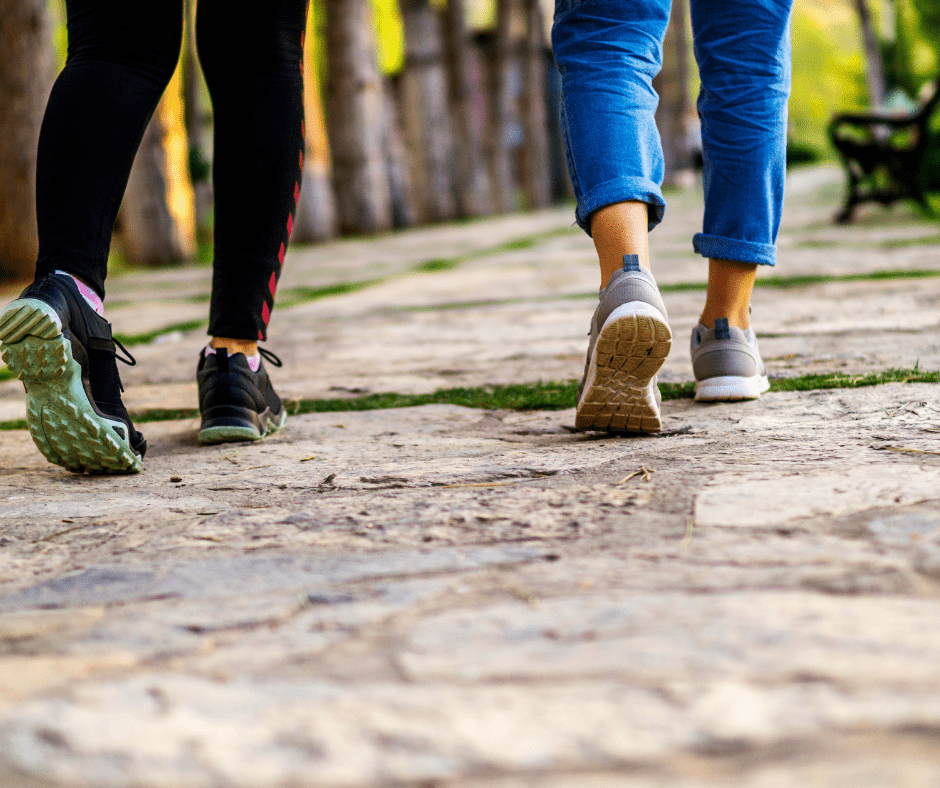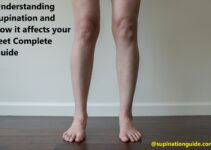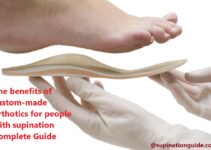Want to reduce the pains of supination? Looking for a natural way to improve your gait? Orthotics might be the answer!
You can find out all about them in this comprehensive guide, from how they work to where you can get them. Get ready to move forward with more comfort and less pain.
Illegally pronating or supinating while walking, running, or engaging in other forms of physical activities can cause a great deal of discomfort and pain. Supination occurs when the foot turns too far outward on the ground as you step. It is especially important to address this issue as soon as possible to prevent further injury and damage to the feet, ankles, lower legs, and hips.
Orthotics for supination provide support and comfort while helping to improve your gait by keeping your foot properly aligned during activities. They do this by providing cushioning and support in specific areas of the foot while also helping control excessive motion in pronated/supinated feet.
In this guide, we will discuss how orthotics for supination work and how they can help improve your gait mechanics, reduce pain associated with supination, and be beneficial for many types of users.
Understanding Orthotics
Orthotics are medical devices used to help correct and support misalignments and imbalances of the foot, ankle, or other parts of the leg. For those who suffer from supination, orthotics can be a key part of reducing pain and discomfort associated with this common condition. In this guide, we’ll discuss how orthotics can improve gait mechanics and reduce pain.
To understand why orthotics are used to treat supination, it helps to gain an understanding of the condition itself. Supination is a foot position in which weight is distributed unevenly across the foot in order to bear more weight on one side than on the other. This can cause biomechanical issues like increased stress on ligaments, decreased range of motion, muscular imbalances and reduced flexibility in walking or running. In severe cases of supination, it can lead to postural problems such as back pain or altered body stance.
Orthotic insoles are special devices designed to redirect your body’s weight from one side of your feet to another. This shift in weight ensures that the ankle joint is better aligned and helps with alignment of your muscles throughout your body for improved health and performance. They come in a variety of shapes and sizes so that you can find just the right fit for your feet based on arch type as well as activity level. Orthotics will provide additional cushioning when needed but still have enough support for activities like running or walking long distances without feeling too stiff or bulky inside your shoes.

Definition of orthotics
Orthotics are arch supports, orthopedic shoes, braces, and insoles that are used to improve the structure and function of an individual’s feet, legs and hips. They work by providing support for the bones and muscles in the feet, helping to correct any misalignments that could be causing pain or impairing movement.
They can also reduce discomfort from foot conditions such as flat feet or high arches, as well as conditions like supination that affect the entire leg. Orthotics can help relieve pain in the lower back and hip region, which is commonly caused by poor posture or improper gait mechanics.
By improving biomechanics of the ankle joint, orthotics can also provide greater stability when walking or running and help prevent injury.
How orthotics work for supination
Orthotics devices play a key role in addressing imbalances in foot movement caused by supination. These devices can be custom-made to fit the contour of the foot, arch and ankle and are designed to absorb shock, reduce stress on the foot, improve gait mechanics, support weakened muscles and provide relief for painful conditions such as plantar fasciitis and tendonitis.
By redistributing weight away from areas that are vulnerable to stress or damage — such as the heel, arch or metatarsal head area — orthotics support and optimize the function of overworked muscles while deflecting force away from tender spots in your feet. Custom-made orthotics can also help with corrective positioning when certain ankle muscles are overly tight or loose by restoring balance during heel strike and promoting proper toe-off during walking or running.
Orthotics incorporated into insoles, braces or shoes may be recommended for those who suffer from overpronation (excessive inward roll of the foot). Orthotics worn inside shoes often feature deeper heel cups with less cushioning than non-customized insoles. This gives more stability around corners while enabling proper tracking of the kneecap (patella), reducing friction throughout lower body joints.
Benefits of Orthotics for Supination
Orthotics for supination can help improve gait alignment, reduce pain and joint stress, and provide added stability when walking. Orthotics are custom-made shoe inserts that are designed to match the contours of feet and align them in the correct position. They can be made of hard or soft material depending on the individual’s needs. Orthotics help improve both gait mechanics and posture as well as reducing foot fatigue.
When it comes to supination, orthotics provide support by controlling excessive pronation of the feet while still allowing a full range of motion. This eliminates excessive stress on the joints, muscles, tendons, and ligaments which can lead to pain and improper alignment of the body during walking or running activities. Orthotics also absorb shock from impact when running or jumping which helps reduce potential injury. By providing an arch support system, orthotics for supination help bring your feet back into their natural alignment which improves stability during regular daily activity and physical exercise.
Comfort is a crucial factor when considering orthotic devices for supination since your feet must be comfortable in order to concentrate on activities such as balancing yourself while walking or running. Orthotic devices are very durable but still allow flexibility so that your foot has room to move while still providing support at all times. This reduced movement helps promote better posture control when standing or engaging in activities such as exercising or sports participation.
Overall, orthotic devices offer various benefits including increased stability, improved gait mechanics reducing joint stressors and discomfort. The ultimate benefit is improved comfort due to increased arch support provided by custom-fitted orthotics specifically tailored to the individual patient’s needs making them ideal for people with excessive pronation or Supination issues who require added support for their arches when walking or engaging in physical activity.
Improved gait and foot alignment
Improving your gait and foot alignment can help reduce your risk of developing painful orthotic conditions. An orthotic is a device worn inside the shoe that provides support, cushioning, and various levels of correction for certain biomechanical irregularities that cause physical discomfort. Orthotics for supination are specifically designed to correct an excessive amount of outward rolling (supination) when a person walks or runs that can lead to pain in the ankles, knees, hips, and lower back.
There are several benefits to wearing orthotics for supination: improved foot alignment; increased stability; greater shock absorption; reduced strain on the feet, ankles, and legs; less joint pressure; improved posture; increased flexibility. Orthotics help patients with supination reduce stress placed on muscles associated with walking or running in order to improve their gait pattern and lessen discomfort caused by improper weight distribution throughout the body.
The design of orthotics varies depending on the medical condition they need to address. Custom-made orthotics provide an exact fit tailored to each patient’s unique feet and come in many different shapes and sizes. Prefabricated orthotic devices are also available but do not offer as much support or attention-to-detail as custom-made products. Additionally, over-the-counter arch supports may be used for those with milder supination problem who want additional cushioning or arch support but don’t need a full custom solution.
An experienced podiatrist should always be consulted before making any decision about utilizing an orthotic device because there is no one size fits all option when it comes to footwear modifications like these. Orthotics for supination can bring relief from fatigue during activities like running and jogging as well as reducing pain caused by improperly aligned feet during normal everyday activities like walking and standing for long periods of time.
Reduced pain and discomfort
People with supination often experience discomfort in the feet and legs due to unnatural loads on their musculoskeletal system. Orthotics that accommodate a person’s biomechanics can help reduce pain and reduce the risk of injury by providing support to the arches of the feet and redistributing pressure appropriately.
They do this by providing cushioning and help with shock absorption, making walking more comfortable. Additionally, orthotics for supination can help improve foot alignment during everyday activities and enhance overall posture as a result of improved foot placement. Improved foot placement not only reduces pain but also provides better stability and balance, which can positively affect walking movement patterns such as gait.
Orthotics are a useful tool for correcting any misalignments in the body that result from conditions like pronation or supination, relieving discomfort while helping to create an environment in which activity is possible.

Prevention of injuries
Given the right biomechanical circumstances, orthotics can provide a number of benefits in assisting the prevention of pain and injuries related to supination. With a custom orthotic, supination can be properly controlled, thus decreasing the risk of injury to areas such as the knee, ankle and foot. Different types of orthotics are available depending on your individual foot type, weight, activity level and lifestyle.
For those who intend to use custom orthotics for injury prevention, it’s important to understand how they work. Orthotics help to stabilize the feet by controlling overpronation and absorb shock during walking or running activities. They have inner cushioning materials which provide additional support to specific parts of the feet. In turn, this reduces stress placed on soft tissue such as ligaments and muscles while also providing support for joints that may not be able take pressure from supination. Additionally, an orthotic will change dynamic pressure in order to reduce shear forces that can cause painful discomfort in certain areas including plantar fascia which is located at the bottom of your feet on the heel.
It’s important however that any orthotic device is regularly assessed for appropriate fit due to any changes in body weight or or activity level as these affect how well an orthotic works after wear and tear over time.
Improved athletic performance
Orthotics are designed to help improve performance and reduce the risk of injury during physical activities such as running and other sports, as well as helping to reduce pain. For those with supination, orthotics can help to realign the foot, redistributing weight evenly and thus enhancing athletic performance through reduced fatigue and improved coordination. Orthotics can also provide better support for the medial arch of the foot, easing soreness around the ankle joint and improving overall balance with each stride.
Moreover, orthotics provide cushioning for areas of discomfort in the foot that result from overpronation or supination. The additional cushioning helps disperse the impact generated with each step due to running or other athletic activities, relieving pain in ankles, knees and hips associated with muscle strain caused by ill-fitting shoes or plain old overuse.
There are several different types of orthotic inserts fitting various needs like running shoes, golf shoes, hiking boots and high heels. They also come at varying prices depending on their level of customization needed as well as their material composition. If a custom orthotic is not within your budget range right now there are plenty of options available off-the-shelf too — it’s a good idea to consult with medical professionals first before making any decisions though!
Choosing the Right Orthotics
Orthotics are designed to correct a variety of conditions, including over-pronation, high arches, and even flat feet. Choosing the right orthotics for your condition can help to improve your gait and reduce associated pain.
When selecting orthotics for supination or high arches, it is important to note the following:
- The strength and durability of the orthotic material should be suitable for the amount of time it will be worn each day.
- Consider the arch height needed for adequate support; many orthotics are offered in varying degrees from minimal elevation to maximum arch support.
- Check with your doctor or physical therapist about whether an accommodating orthotic would benefit you. Accommodating orthotics are designed with gel cushioning that reduce pressure on specific body parts (typically around first contact points during periods of standing or walking).
- Determine if a semi-rigid vs. rigid orthotic would be optimal for the amount of stability required; most people with high arches or supination benefit from a semi-rigid device since they promote both support and flexibility while walking; if more stability is needed then rigid devices may provide that extra protection but could limit natural foot motion in certain directions.
- Finally, consider custom made versus off-the-shelf systems. Customized systems may cost more but offer an enhanced fit that many find extremely beneficial; off-the-shelf systems can offer good quality but usually require some modification at home or by a professional provider to get an exact fit.
Consultation with a specialist
If you experience any pain or other ongoing issues related to supination, it’s important to seek medical care from a qualified specialist. An orthopedic doctor, physical therapist, or podiatrist can assess your condition and recommend a product that may provide relief.
When selecting an orthotic device for supination, it’s best to consult a professional who can offer an individual assessment of your feet and overall anatomy. This is especially important if you are dealing with chronic pain or discomfort caused by a unique combination of feet conditions. A professional can help you identify the specific causes of your individual discomfort and recommend the ideal corrective product for your needs.
The specialist may also recommend certain activities that may help reduce the effects of supination and strengthen the muscles in your feet, ankles and legs. In some cases, these activities may include stretches or specialized exercises aimed at improving foot strength and stability as well as providing relief from discomfort caused by supinated feet. It is also essential to wear shoes specifically designed to improve pronation if necessary (often called stability shoes). Along with prescribed orthotic devices, these supportive shoes can greatly improve one’s mobility while reducing any resulting strain or fatigue when walking or running.
Custom vs over-the-counter orthotics
Custom orthotics are constructed from detailed impressions of a patient’s feet and are often prescribed to those with specific conditions or unique gait patterns. Though custom orthotics can provide the best support for your supination, they can be expensive and time-consuming to obtain.
Over-the-counter orthotics are more affordable than custom models, readily available in most drug stores and sporting good stores, and easy to fit into your shoes. These devices are designed to provide general support and stability while absorbing shock while engaging in activities. However, over-the-counter orthotics may not provide the same level of individualized comfort or efficiency when treating supination as a custom device.
Conclusion
In conclusion, orthotics for supination can be highly beneficial in preserving an even gait, maintaining foot function and lessening pain in the feet, ankles, legs and lower back. Studies have proven that this type of device is effective in reducing pronation-related discomfort and aiding foot stability. Additionally, orthotic inserts may reduce plantar fasciitis flares and the likelihood of injury from misalignment or incorrect loading during gait activities.
When determining which type of orthotic is best for supination, it’s important to speak to a physician or podiatrist for proper guidance to ensure optimal results. Orthotic inserts are meant to prevent further injury through proper alignment and redistribution of forces on the foot; thus allowing for improved performance during activities such as walking, running and jumping. Investing in a quality orthotic device tailored specifically to your needs may be the key to keeping your feet happy and pain free!

FAQ’s
How do you fix supination gait?
Supination gait can be fixed by wearing proper shoes, doing exercises to strengthen weak muscles, and using custom-made orthotics.
What is a strengthening exercise for supination?
Calf raises, toe curls, and ankle eversions are some of the strengthening exercises that can help with supination.
How can I improve my walking gait?
Improving walking gait can be achieved through various methods such as practicing good posture, wearing proper shoes, and doing gait training exercises.
What muscles are weak with supination?
The muscles that are commonly weak with supination are the peroneus brevis, peroneus longus, tibialis anterior, and extensor digitorum longus.
What is the strongest muscle for supination?
The strongest muscle for supination is the biceps brachii muscle located in the upper arm.
What shoe is best for supination?
Neutral or cushioned shoes with good arch support and shock absorption are the best options for supination.
Can you cure supination?
Supination cannot be cured completely, but it can be managed through various treatment methods such as wearing proper shoes and using orthotics.
What type of insole is used for supination?
Insoles with a deep heel cup and arch support are recommended for supination.
Are wide shoes better for supination?
Wide shoes are not necessarily better for supination, but shoes with a wider toe box can provide more room for the toes and reduce pressure on the foot.
What causes extreme supination?
Extreme supination can be caused by various factors such as genetics, anatomical abnormalities, and muscle imbalances in the foot and leg. It can also be a result of wearing shoes that do not provide enough.
See Also :
- Best running shoes for supination
- Best sandals for supination
- Best shoes for over supination
- Best shoes for supination and plantar fasciitis
- Best shoes for supination


